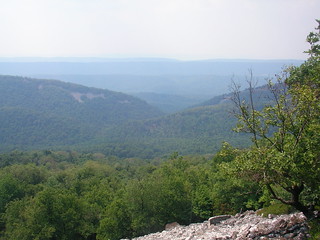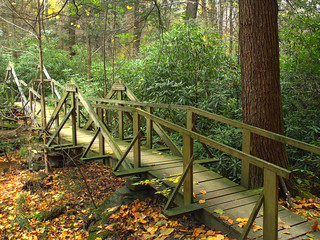If you're traveling north on the trail, and heading through Fulton County, then you'll come upon Vanderbilt's Folly. It is an uncompleted rail that was being built under the guidance of William Vanderbilt to give competition to the Pennsylvania Railroad. This was in the latter-1800s. Many train tunnels were dug through the mountains but the rail was never completed due to the the bankrupting of the rail project. After 1940, many parts of the unfinished railway and a few tunnels became a section of the Pennsylvania Turnpike. Today, one of the tunnels has been abandoned since the Turnpike bypass in 1968.
The name of the trail possibly comes from a Native American trail that was called the Standing Stone Path. It connected Fort Littleton to Fort Standing Stone. Fort Standing Stone which later became Huntingdon. In the mid-1800s, industrialization came to the area and the forests were made into lumber for buildings and homes being built in the area. The forest wood was also used in furnaces to melt the iron ore from the area. Iron became very profitable and the furnaces began to be built all over Central Pennsylvania. The Standing Stone Trail makes use of some of these trails that were used for long-gone railroad grades and logging trails.
At Mapleton, aka Mapleton Depot, the trail goes across the Juniata River at Jacks Narrows. Nearby is the well-known Thousand Steps. The steps were built in the 1950s by workers from the ganister stone. The quarry itself has existed since 1900 and was said to had its most success in the early 1920s. Up there you'll also find an old quarry building.
Around a mile eastward from the Thousands Steps were two Native American trails that were called the Frankstown Path and the Juniata Path. In 1744, the trader Jack Armstrong was killed during a time when tensions were high between Native Americans and Settlers. Armstrong was killed in relation to his trading activities with a Delaware. Shikellamy and Conrad Weiser helped keep tensions low by fully investigating the murder. In memory, Jacks Mountain and Jacks Narrows are named after him.
From the highest point and over Jacks Mountain there is beautiful scenery to be seen. For rock climbers, there are a few areas that are good for a challenge. One such 'challenge' is the yellow-blazed trail that leads to Hunter's Rocks. This trail section is also great for hikers and features rare and endangered flowers, including Obolaria, and the endangered Putty Root Orchid. Also, Lady Slippers are in abundance in this area.
The next part of the trail leads to the Stone Mountain and Hawk Watch and also provides excellent views. This section is an easier part of the trail, as the trail is more level for miles. The trail then heads into Greenwood Furnace State Park. The furnace existed from the mid-1800s and was the last to stop being used. In fact, the furnace and many structures from those days are still standing and provide a great visual history. Greenwood Furnace State Park is also a great place to take a rest, have a swim, and have a picnic in the warm summer months.
If you head north on the Greenwood Spur section of the trail, you'll pass the historic Greenwood fire tower. Past that, you'll be in he Alan Seeger Natural Area. It was named after Alan Seeger, who was American poet and WWI French Foreign Legion Volunteer who died in the Battle of the Somme. It was Colonel Henry Shoemaker who named the area. Also, Alan Seeger was the uncle of Pete Seeger. This part of the trail continues on and connects to the Mid State Trail at the Detweiler Run Natural Area.
Jacks Narrows and Thousand Steps
Rocky Ridge Natural Area
Stone Mountain and Hawk Watch
Vanderbilt's Folly
Monument Rock
Butler Knob and Throne Room




